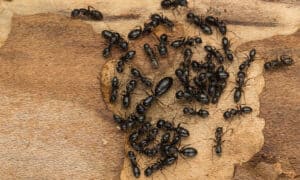In the heart of Pennsylvania, as the summer sun graces the land, a miniature world springs to life. Amidst the sprawling greenery and bustling forests, a diverse community of ants emerges from their hidden nests. These tiny architects, clad in segmented bodies and delicate antennae, embark on a collective mission. They tirelessly scurry and explore, building intricate pathways and harvesting nature’s bounties.
Let’s dive into the extraordinary world of Pennsylvania’s summer ants and get to know 5 of these tiny but hardworking creatures.
1. Allegheny Mound Ant (Formica exsectoides)
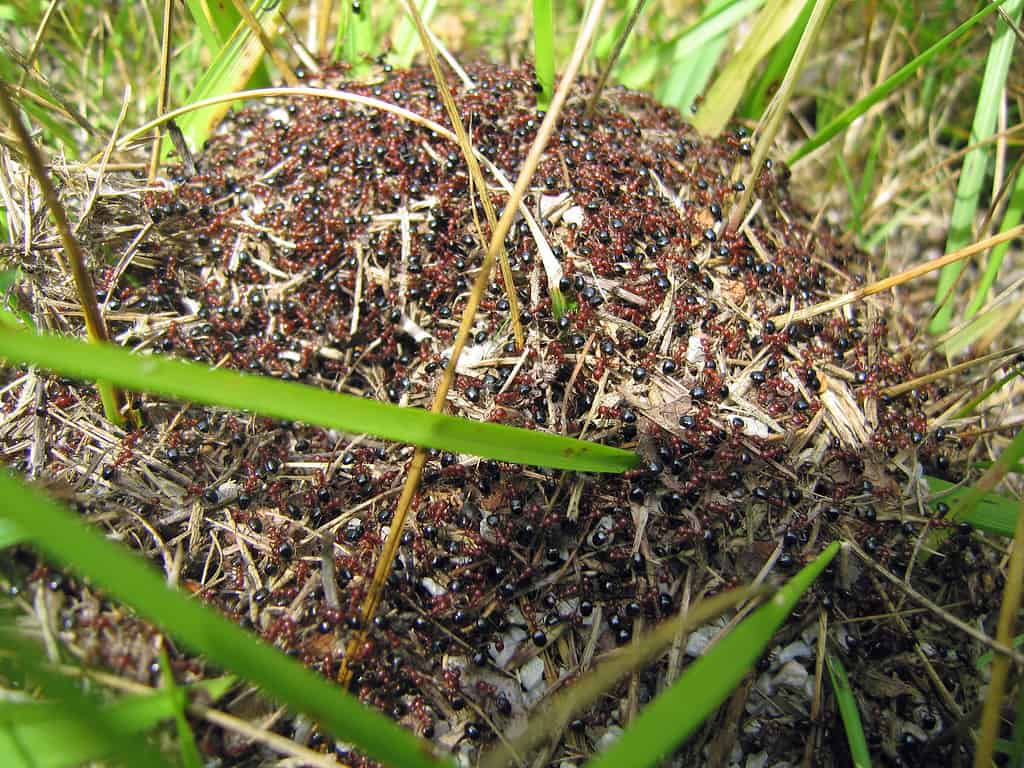
The colonies of Allegheny mound ants are incredibly complex.
©Allegheny Mound Ants, Formica exsectoides – License
Pennsylvania hosts a diverse range of ant species, including the remarkable Allegheny mound ant. These ants possess a captivating appearance, with a reddish head and thorax, while their abdomen and legs exhibit dark brown to black shades. Workers vary in size from 1/8 to 1/4 inch, while the queens are larger, measuring between 3/8 and 1/2 inch long.
The colonies of Allegheny mound ants are incredibly complex. Interconnected mounds can be observed, with tunnels extending approximately 3 feet into the ground and 4 feet upward within the mounds. These colonies are commonly found in open forested areas and old-field habitats.
The diet of Allegheny mound ants primarily consists of insects and honeydew, a sugary substance produced by sap-feeding insects such as aphids or scales.
The establishment of new colonies predominantly occurs in late May and early June. As the temperatures rise during spring, the colonies become active, gradually constructing their mounds and clearing the vegetation from the surrounding area. Their activity continues until the onset of fall.
2. Odorous House Ant (Tapinoma sessile)
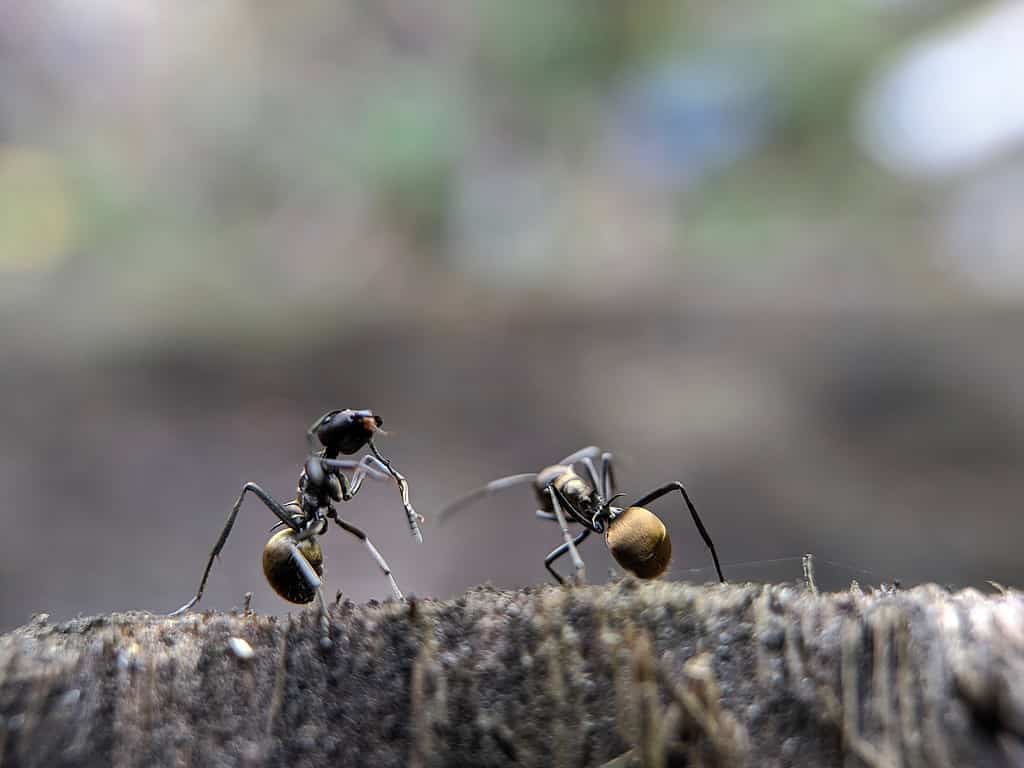
Odorous house ants have a sweet tooth and particularly enjoy indulging in honeydew.
©Dhe Tong/Shutterstock.com
The odorous house ant, widely prevalent not only in Pennsylvania but throughout the entire United States, is notorious for its unpleasant scent.
These ants are black or dark brown in color, featuring a concealed petiole node hidden beneath their abdomens. In terms of shape, the thorax of the odorous house ant appears irregular when observed from the side. Its name derives from the foul smell of rotten coconuts or blue cheese emitted when crushed. They measure between 1/16 to 1/8 of an inch in length.
Odorous house ants have a sweet tooth and particularly enjoy indulging in honeydew. They exhibit a tendency to relocate their nests approximately every three months in response to rainfall.
Odorous house ants, both indoors and outdoors, establish their nests in various locations. Indoors, they prefer to be near sources of moisture, such as wall voids next to hot water pipes, within heating systems, or even inside wood that has been damaged by termites. Outside, they are often discovered in exposed soil or beneath piles of firewood.
While odorous house ants do not pose a public health risk, it is advisable to avoid them as they can contaminate food. They are also known to attract other pests, such as spiders and centipedes, which can be a nuisance.
These ants tend to invade homes, most commonly during rainy weather, as their natural food supply gets washed away from vegetation. Although these ants can remain active throughout the year indoors, they typically spend the winter as workers or larvae outdoors until the arrival of warmer temperatures in March. It is during this time that they resume foraging activities until the weather cools down in September or October.
3. Pavement Ant (Tetramorium caespitum)

These ants typically emerge in the spring and are most active between March and May.
©Ezume Images/Shutterstock.com
Pavement ants hold the title of the most encountered ant species found in Pennsylvania. Their distinctive name is derived from their preference for nesting near or beneath driveways and sidewalks.
These ants exhibit a brown to black coloration, accompanied by lighter legs and antennae. The waist, or pedicel, consists of two nodes. Their 12-segmented antennae possess a three-segmented club. These diligent workers measure a diminutive 0.1 to 0.2 inches in size.
Pavement ants have an adaptable diet, consuming both sugary and oily food sources. In natural habitats, they primarily inhabit open meadows, seeking refuge beneath rocks and various debris. In urban settings, these resourceful ants establish their colonies under foundations, patios, and sidewalks. Typically, a solitary queen oversees a colony, although larger communities may harbor additional queens.
During the spring, neighboring ant colonies engage in grand battles on sidewalks, leaving hundreds of fallen soldiers behind. A single nest of pavement ants can contain an impressive workforce of up to 10,000 diligent workers.
Pavement ants emerge for their nuptial flights as the late spring and early summer months arrive. Drones and newly emerged queens eagerly venture out in search of suitable mates at this time.
4. Pharaoh Ant (Monomorium pharaonis)
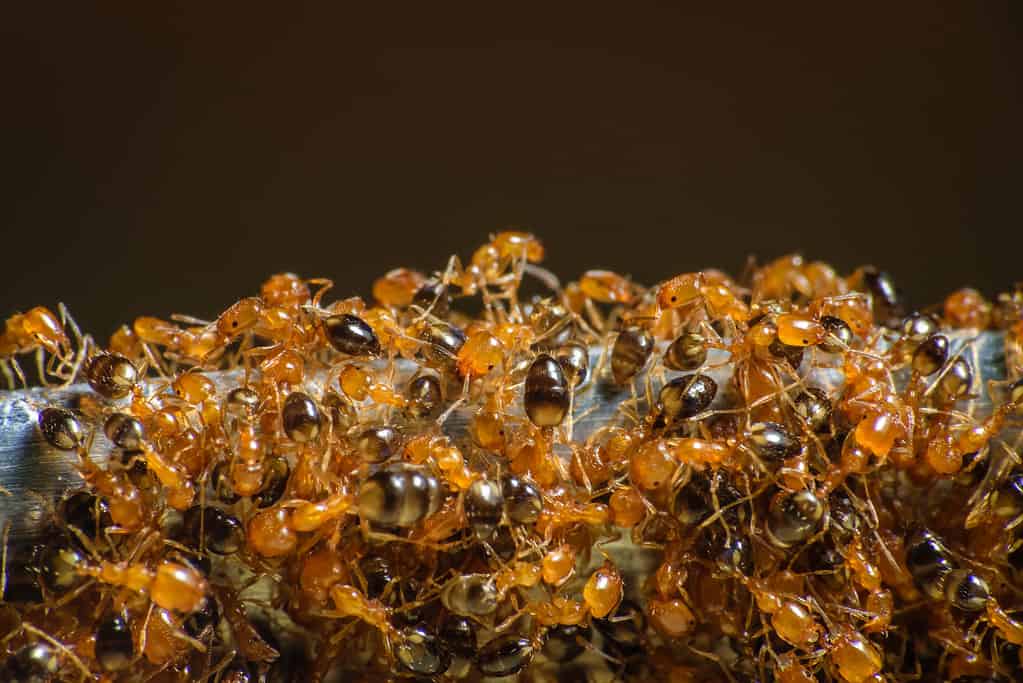
They are known for their yellow or light brown color.
©Suman_Ghosh/Shutterstock.com
Pharaoh ants, another ant species prevalent in Pennsylvania, often go unnoticed due to their small size. Originating in northern Africa, these ants have now established themselves as one of the most widely distributed ant species worldwide.
Displaying a spectrum of hues ranging from light yellow to red, pharaoh ants typically have either red or black abdomens. Notably, the queen ants tend to be darker in color compared to the worker ants. The workers themselves measure a mere 1/16-inch to 3/32-inch in size.
Pharaoh ants exhibit a diverse diet, consuming various substances, including syrups, fruits, meats, and deceased insects. Consequently, they pose a particular concern for businesses operating in the food industry, as well as grocery stores, hospitals, and apartment buildings.
Indoors, these ants establish nests in warm and humid environments close to food and water sources. Their nesting sites are typically concealed within inaccessible areas, such as wall voids, behind baseboards, within furniture, and beneath floors.
Pharaoh ants remain active indoors throughout the year, although their population surge occurs predominantly between June and August when they emerge in large numbers.
5. Little Black Ant (Monomorium minimum)
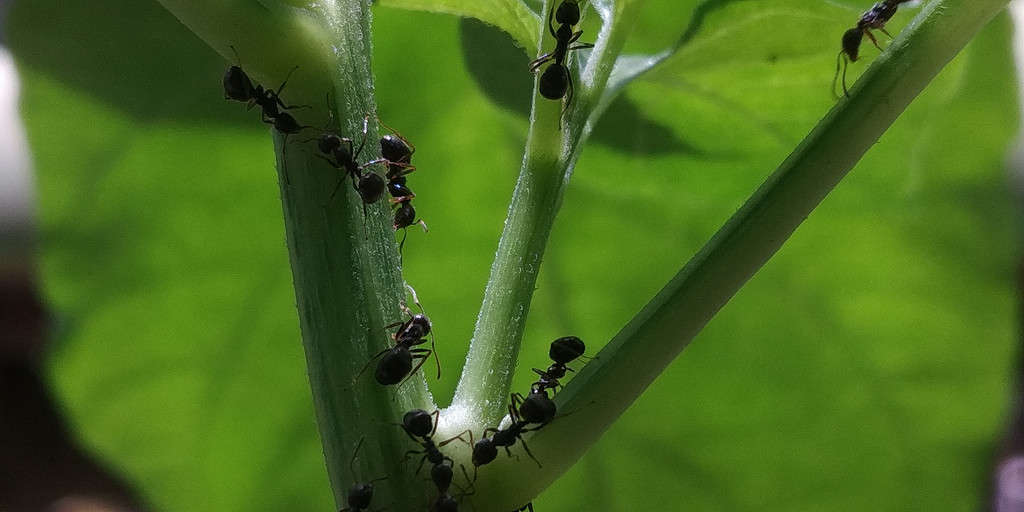
These ants are commonly encountered in wooded areas.
©iStock.com/Rahmat M Pandi
Little black ants, as their name implies, are smaller in size compared to other ant species. They are indigenous to North America and are particularly abundant in the state of Pennsylvania.
Their coloration varies from dark brown to jet black. With 12 segmented antennae, these ants measure around 1/16″ to 1/8″ in length for adults, while queens reach up to 1/8″.
Feeding on a diverse range of substances, including grease, oil, meats, fruits, vegetables, cornmeal, and sweets, these small ants also consume other insects, honeydew, and plant secretions.
Little black ants are commonly encountered in wooded areas. They establish nests beneath rocks, decaying logs, or piles of bricks and lumber in outdoor spaces. Indoors, they construct nests within woodwork and wall voids. The colonies vary in size, ranging from moderately sized to large, accommodating up to 2,000 workers and multiple queens.
During the period spanning June to August, little black ants often form swarms, foraging in distinct trails and frequently appearing along sidewalks.
Other Insects Set to Emerge In Pennsylvania
In addition to ants, summertime brings many other visitors from the insect kingdom.
1. Eastern Tent Caterpillars (Malacosoma americanum)
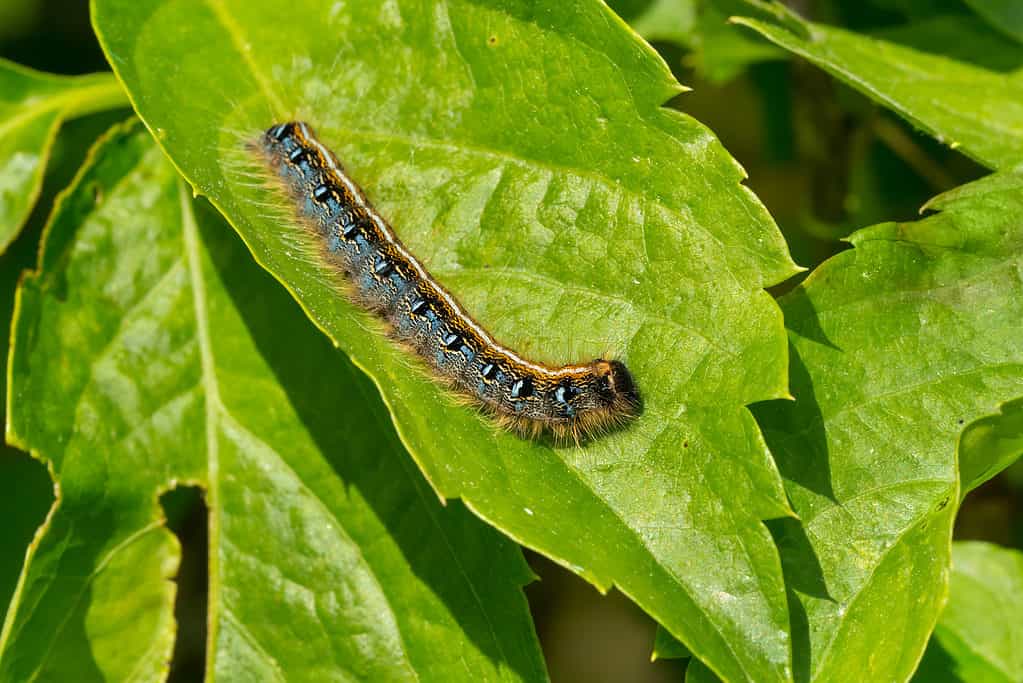
Eastern tent caterpillars may experience outbreaks, resulting in the defoliation of deciduous forest trees as well as ornamental trees.
©Paul Reeves Photography/Shutterstock.com
The collective creation of web tents is one of the distinguishing characteristics of Eastern tent caterpillars. These distinctive structures are typically found in the junctions and forks of branches during the spring and early summer.
With their vibrant blue, black, and orange markings, accompanied by a white stripe along their backs, the larvae of Eastern tent caterpillars display a hairy appearance. Although generally smooth, they do possess a series of protruding hairs along the sides of their bodies. At their maximum growth, they reach a length of around two inches.
In certain instances, Eastern tent caterpillars may experience outbreaks, resulting in the defoliation of deciduous forest trees as well as ornamental trees. While this defoliation can be a cause for concern among homeowners and landowners, it is important to note that healthy trees can typically withstand this feeding and recover naturally without requiring any intervention.
Towards the beginning of summer, as the caterpillars reach maturity, they embark on a migratory journey away from their tents, seeking out a sheltered location to construct cocoons and undergo the pupation process. In late June and July, the adults emerge from their cocoons and lay egg masses that can contain anywhere between 150 to 350 eggs.
2. Japanese Beetles (Popillia japonica)
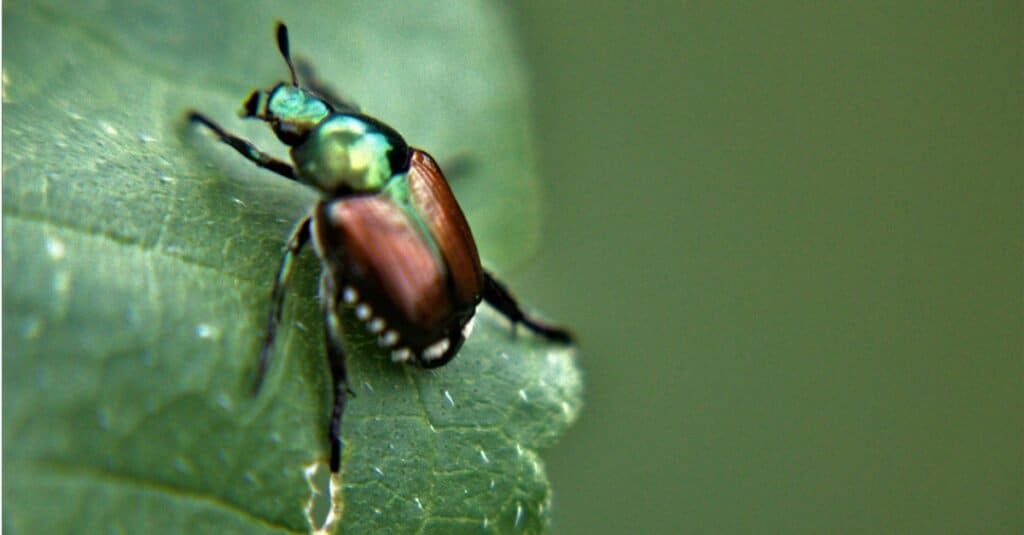
Originally from Japan, the Japanese beetle was spotted in the United States in 1916.
©iStock.com/Justin Tahai
Japanese beetles are a significant concern for gardens in central Pennsylvania, as they are considered the most problematic garden pest in this area.
These insects are identifiable by their metallic green hue, measuring just under half an inch in length. Their coppery-brown wing covers, called elytra, are positioned on their backs, and small white hair clusters can be seen along their dorsal edges. Although male and female beetles are similar in appearance, females are usually slightly larger.
The issue with Japanese beetle infestations arises from the adult insects’ insatiable hunger for over 300 varieties of plants, flowers, and fruits. Furthermore, their larval stage, known as grubs, consumes turfgrass roots. It is essential to note that Japanese beetles do not pose any danger to humans since they do not bite or carry diseases.
Adult Japanese beetles typically emerge in late June or early July and have the ability to fly several miles in search of food. Their peak feeding activity primarily occurs in July and August, though some may continue to feed until September.
3. Eastern Carpenter Bees (Xylocopa virginica)
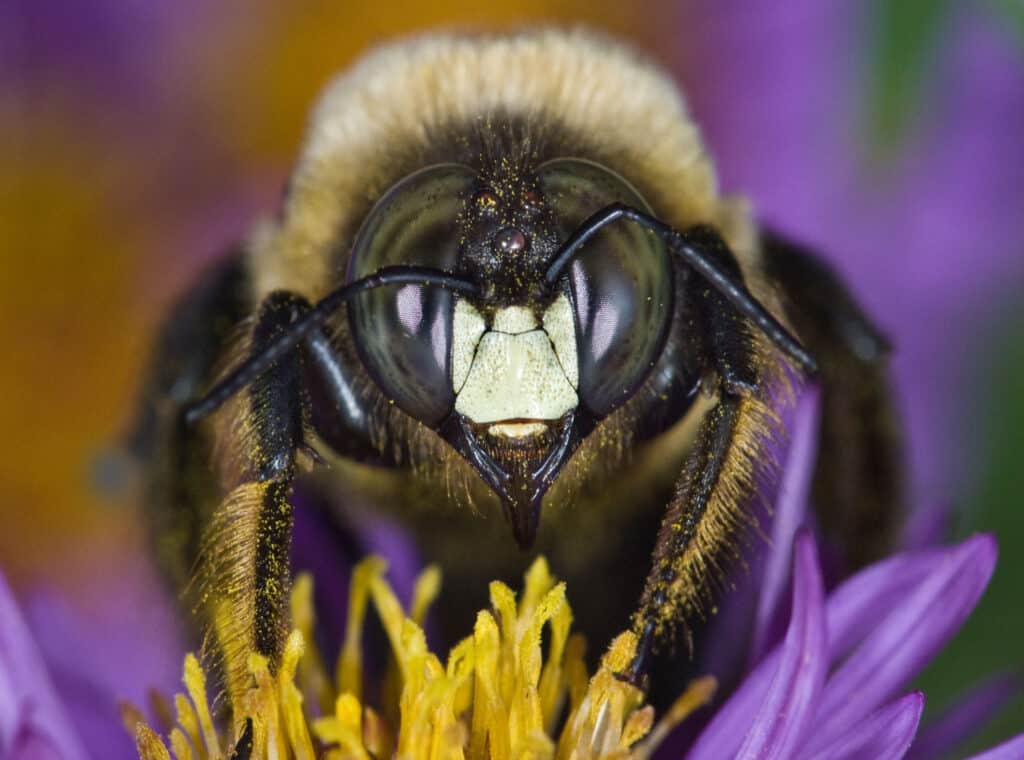
Carpenter bees have large eyes and a glossy, hairless abdomen.
©Gerry Bishop/Shutterstock.com
In the state of Pennsylvania, you can easily find a solitary species of large carpenter bees known as Xylocopa virginica.
The appearance of the eastern carpenter bee resembles that of a bumble bee. It possesses a distinct black and shiny abdomen. It’s worth noting that these bees are not aggressive and are unable to sting, particularly the male ones, which can be identified by their white faces.
Carpenter bees have a fascinating behavior of creating nests by excavating wood, hence their name. They exhibit a solitary lifestyle, and while the females are capable of stinging, they rarely do so unless provoked or disturbed.
The significance of carpenter bees lies in their role as essential pollinators for various flowering plants found in gardens, natural areas, and farms. Interestingly, a significant portion of our agricultural crops, approximately 15%, rely on native bees like the carpenter bees for pollination.
Despite their ecological importance, carpenter bees are often perceived as pests. They have the potential to cause damage to wooden structures.
One can observe these bees around houses and other wooden constructions during the spring and summer seasons.
4. Boxelder Bugs (Boisea trivittata)
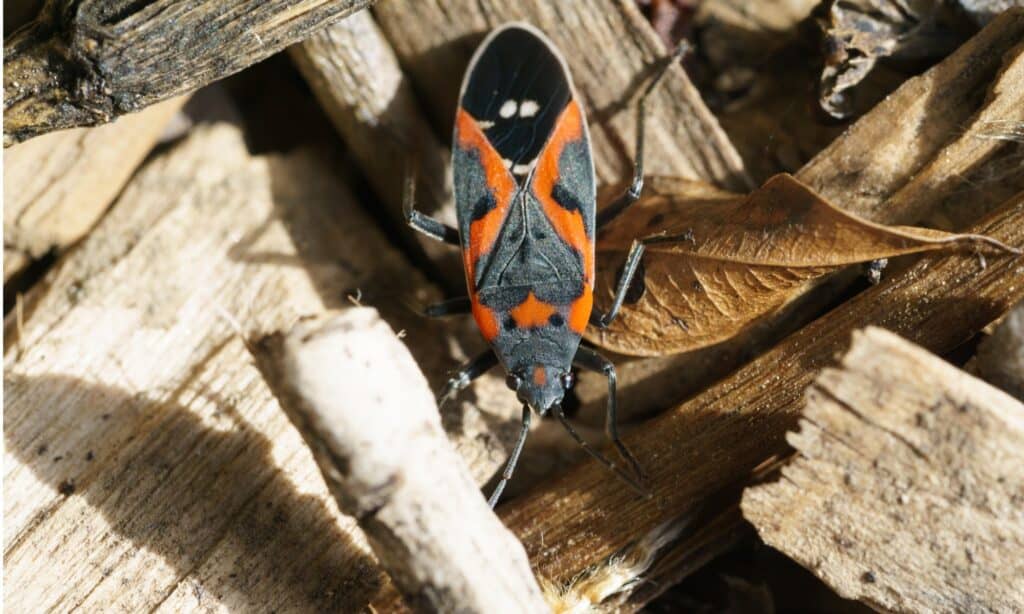
While boxelder bugs are not known to sting, transmit diseases, or commonly bite humans, there have been occasional reports of defensive biting.
©iStock.com/fusaromike
In Pennsylvania, boxelder bugs, scientifically known as Boisea trivittata, are categorized as “nuisance pests,” posing no significant danger or disease transmission.
These bugs feature a distinctive appearance, with a black body adorned with reddish or orange markings on their backs. With a somewhat flattened and elongated oval shape, adult boxelder bugs measure about half an inch in length. They possess six legs and two antennae that are typically half the length of their bodies.
While boxelder bugs are not known to sting, transmit diseases, or commonly bite humans, there have been occasional reports of defensive biting. They do not cause any notable damage to homes or plants. However, it’s worth noting that their excrement can leave stains on light-colored surfaces. Smashing them may release an unpleasant odor.
During late April to early May, these bugs emerge from their hibernation state. The emergence coinciding with the opening of buds on boxelder trees. They then fly back to their host trees and remain active there until late summer or early fall.
The photo featured at the top of this post is © iStock.com/Rahmat M Pandi
Thank you for reading! Have some feedback for us? Contact the AZ Animals editorial team.




